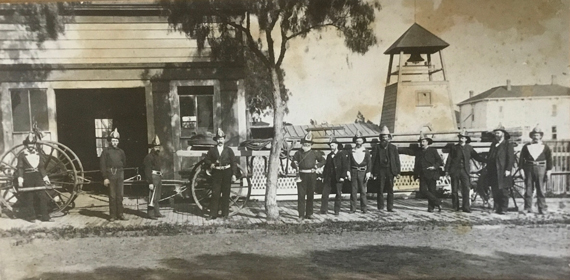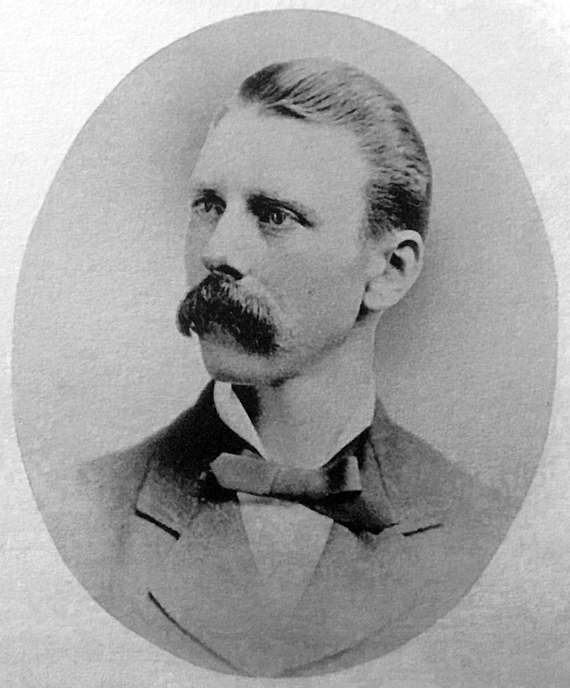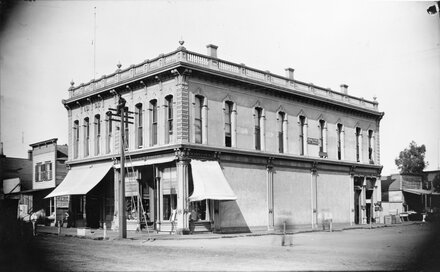|
The Marstons: A California Family - Part 14
George Marston: Fired Up for Safety
By Robin Lakin
September/October 2024

George W. Marston (third from right) and his fellow San Diego volunteer firefighting team at the alarm bell tower and fire department building on Fifth Street between Broadway and C Streets, in the early 1880s. A contemporary identified the twelve men standing in front of the hand-drawn hook and ladder as, from left to right: Joe Mumford; John Clark; Albert Hurtz; Frank Snyder; Mr. Mumford (probably Joe’s father, John); Theodore Fintzelberg; John Moffitt; Charles Coster; Mr. Stewart (first name not given); Marston; Cyrus Arnold; and Joe Winter. Some wear uniform shirtwaists, and all wear leather fire hats.
 George W. Marston at the time he served on San Diego’s volunteer firefighting team. |
 The Marston Store, a few blocks north of the fire station at Fifth and F Streets, where George was a volunteer firefighter. All photos courtesy SOHO collection |
George W. Marston wore with distinction many hats, among them a top hat, baseball cap, bowler, straw boater, flat golf cap, and a crash cap for auto driving. Perhaps the most interesting chapeau in his closet was a leather fireman’s hat.
In the 19th century, providing essential heat, light, and sustenance often fueled flames that destroyed property and claimed life. An improperly lit or fueled fire in a hearth or stove, a lantern set too close to Mrs. O’Leary’s cow, a runaway blaze from routine personal trash burning, children fiddling with matches, and shady arsonists could create citywide damage. Local arson fires became as common as the fire insurance and fire-proof brick and roofing advertisements in the San Diego Union.
Efforts to establish local fire protection began May 17, 1869 with the first meeting of the all-volunteer Pioneer Hook & Ladder, held at Horton Hall. Fifty brave men signed up to form the crew.
By 1872, the organization owned a hook and ladder—a narrow, high-wheeled red wagon with a long rear tiller supporting half a dozen ladders, and six buckets hung over each side. Buckets were filled with water from personal wells to battle the flames. While this coordinated effort was better than nothing, San Diego lagged in establishing an effective, organized fire-fighting system and state of the art equipment.
That same year on April 21 at 10am, a column of smoke rose above Old Town’s flagpole and was visible from the Horton House cupola in New Town. With no fire protection there, New Town’s hook and ladder company raced north, but traveling the three-mile distance took too much time and the buildings were unsalvageable.
Kitchen and arson fires continued with no loss of life until Mrs. Campbell MacKenzie, wife of the proprietor of the National Hotel at Seventh and H Streets, used kerosene to hasten the kindling of the kitchen stove, causing an explosion. Tragically, the firefighters’ delayed response resulted in Mrs. MacKenzie’s death, witnessed by her 12-year-old daughter, Annie. Everyone agreed San Diego desperately needed to implement a warning system and upgrade its firefighting equipment, water supply, and training.
A brief improvement came in 1878: a $95 fire alarm bell weighing 550 pounds. It measured over 3 feet across and “will be heard for miles around.” The investment lasted about a year and a half until it broke, and San Diego was sans fire bell for another 18 months until the purchase of a 1,000-pound bell for $300.
During the first few years George lived in San Diego, he quickly transitioned from an employee to the owner of the Marston Company in 1878. He also owned the store’s false front building on Fifth Street. As his wooden building was susceptible to fire, George joined the volunteer firefighters protecting the business and residential community.
This is how George came to add a leather fire helmet to his hat collection, and firefighting training to his well-developed toolbelt of skills. This crucial training turned personal a few years later when the hook and ladder company battled a fire that started in brother-in-law Charles Hamilton’s business nearby. Sadly, the fire decimated Hamilton’s store along with several other buildings on Fifth Street.
It took another year to establish a paid, formally trained firefighting force in 1889. Until then, San Diego benefited from the dedication of the scores of volunteers who risked their lives to protect their community. George Marston stepped up his community service by becoming San Diego’s Fire Commissioner. With that new role, he put away his well-worn leather helmet for the last time.
BACK to the table of contents
Read the rest of the ongoing The Marstons: A California Story History Series.
|
2025
2024
2023
2022
2021
2020
2019
2018
2017
2016
2015
|






